San Paolo fuori le Mura – St. Paul outside the walls – is one of four major basilicas in Rome. The current church, once the largest in the world, is a reconstruction of the fourth century church which burned down in 1823.
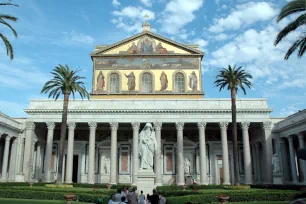
The church is located at the presumed burial place of St. Paul, which lies outside the Aurelian Wall, hence its name.
History
St Paul’s burial place
The apostle Paul was beheaded in the year 67, and his body was brought to a sepulchral area (and not an underground necropolis, as was the case with St. Peter). The burial place was already venerated in the first century, when a Cella Memoriae – a small memorial building – was erected here.
Construction

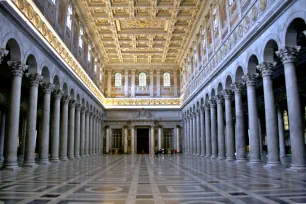

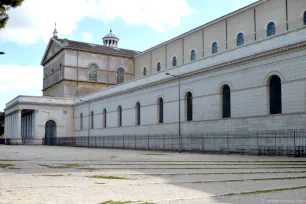

A first basilica, commissioned by Roman Emperor Constantine I, was built in 324 on top of the Cella Memoriae. In 386 this basilica was already deemed too small and Emperor Valentinian II ordered the demolition of the building. It would be replaced by a new, much larger structure. Valentinian’s successor, Emperor Theodosius, appointed Ciriades as lead architect.
Ciriades designed a monumental structure with five naves whose roofs rest on eighty columns. Like most basilicas at the time, it was preceded by a large atrium with a central fountain. The church was consecrated in 390 by Pope Siricius, but it was only completed five years later during the reign of Emperor Honorius.
More expansions followed during the next centuries, and by the ninth century, this was the largest church in Rome. It held that title until the current St. Peter’s Basilica was completed in 1626. After being sacked in 846 by the Saracens, the church was quickly restored and expansions and restorations continued until the eighteenth century.
Destruction and reconstruction
Disaster struck on July 15, 1823, when careless roofers spilled burning tar on the wooden beams that supported the leaden roof. The church was soon engulfed by fire and burned to the ground. Only the apse, the cloister, the triumphal arch, the apostle’s tomb and the south wall survived. A faithful reconstruction started soon after the disaster, thanks to funds provided by donations from around the world. The church was reconsecrated in 1854.
The Church Today
The church we see today may not be the original fourth century basilica, but it is still an imposing building, 131 meters long, 65 meters wide and 29 meters high (approx 430 x 213 x 95 ft). Its vast interior is particularly impressive, and gives us a good idea of what ancient Roman basilicas must have looked like.
Exterior
The impressive atrium on the west side of the basilica was added in the late nineteenth century. It was built by Guglielmo Calderini after a design by the neoclassical architect Luigi Poletti. The atrium consists of a four-sided portico with seventy Corinthian columns. At its center stands a large statue of the apostle Paul, created in Carrara marble by the Italian sculptor Giuseppe Obici.
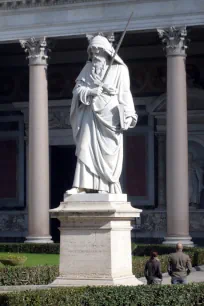
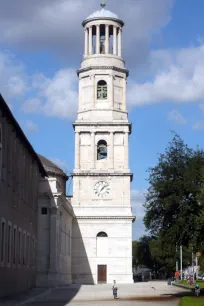
The mosaics on the front facade are also from the nineteenth century. They were created by Filippo Agricola and Nicola Consoni who based their design on the original mural from the tenth century. It shows four apostles from the Old Testament at the bottom. Above them is Christ flanked by the saints Peter and Paul.
The central bronze door was created in 1930 by Antonio Maraini. To the right is the Holy Door, only opened during Jubilee years (once every twenty-five years).
The basilica’s campanile (clock tower) was originally built in the eleventh century near the front facade. The current tower was built in 1860 toward the east of the basilica, near the apse. It holds seven bells, five of which are still original.
Interior
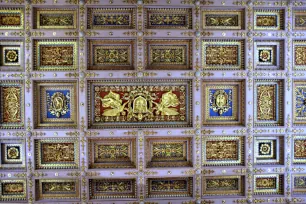
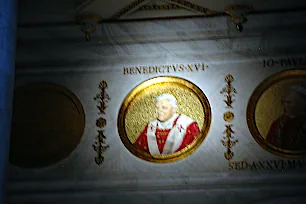
The church’s enormous size becomes apparent once inside. Its original floor plan was probably based on that of the Basilica Ulpia at the Forum of Trajan. Four rows of twenty granite columns separate the central nave from its aisles.
The columns are new; the original ones were all taken from ancient Roman temples. They support arcaded entablatures with above a series of so-called tondi, circular paintings of popes. Unfortunately, most of these paintings were damaged by the fire of 1823. They have all been restored, but some of the inscriptions are lost forever. All 267 popes, starting with Saint Peter, are shown. There are now very few tondi still available, and according to legend, the world will end when the last tondo is filled.
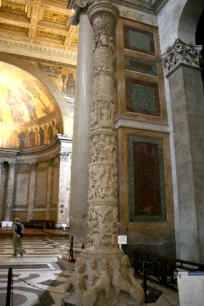
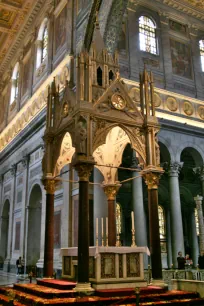
One of the most interesting items that escaped the disastrous fire is the five-and-a-half-meter-tall Easter candle stand, created around 1170 by Nicolo di Angelo and Pietro Vassalletto. It is decorated with carvings that represent scenes from the bible. It looks packed with numerous figures crammed into a small area. At the foot of the stand are mythical figures, half-human, half-animal.
The triumphal arch across the nave rests on Ionic columns and is embellished with a mosaic from the fifth century that was restored after the fire. At the center of the arch, in a circle, is a stern looking Christ. Birds (representing the four evangelists), angels, twenty-four elders and, below, the saints Peter and Paul, all flank the figure of Christ.
Another highlight is the Venetian mosaic in the apse. It was created in 1226 for Honorius III and replaced the original mosaic from the fifth century. Here you can see Christ on a throne accompanied by Peter, Paul, Andreas and Luke.
The Gothic baldachin in marble at the high altar was created by Arnolfo di Cambio in 1285. Below the altar is the confessio, with the grave of Saint Paul.
Cloisters
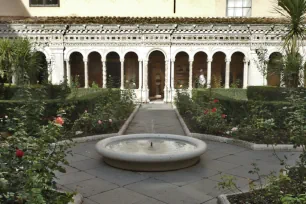
At the end of the right transept a door leads to the chiostro (cloisters), still authentic since it was untouched by the fire of 1823. The cloisters were originally created between 1205 and 1241 by Pietro Vassalletto, who also built the cloisters of the Lateran basilica. This is one of the finest cloisters in Rome, with beautifully sculpted columns in a multitude of shapes; some are completely smooth while others are spiraling or octagonal and encrusted with colorful mosaics.

